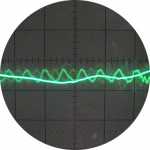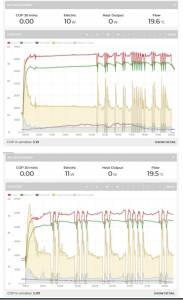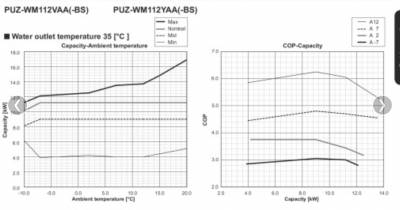Great thanks everyone, lots of food for thought.
So the key takeaway is to not trust the nameplate capacity, and you have to size instead based around the nominal capacity (usually listed as -2c). And, for some models that's basically the same (e.g. the Ecodan 11.2kw still outputs 11.2kw down to -5c), and for others it's a massive difference (the Daikin 16kw HT drops to 11.5kw at -2c). So in this case the 11.2 Ecodan and the 16 Daikin are on a par. Confusing!
Posted by: @derek-mQuestion the need for such items as a buffer tank or plate heat exchanger, and if absolutely necessary then make allowance for these in the sizing of the heat pump.
I was chatting to my proposed installer yesterday, he said I would need a buffer tank (in fact 2, one for the rads and one for underfloor heating). I asked why, he said to deal with the expansion of the water in the heating system as it's heated, and to provide a buffer of hot water used when the heatpump does a defrost cycle. I've goggled needing a buffer tank with a heat pump and there are lots of articles saying that it's necessary.
You seem to be saying that a buffer tank is only rarely necessary. Why do you say that?
@Fazel @Derek_M
Well here is some interesting behaviour last night. I lowered the flow temperature at the top end of my WC curve by 2 degrees bringing it down from 37C at 15C OAT (top graph) to 35C at 15C OAT (bottom graph)
Although last nights was a shorter run length, cycling appeared much more quickly, COP was virtually identical. We were both warm enough in the house but the thermostat in the hall never reached the 23C set point
House-2 bed partial stone bungalow, 5kW Samsung Gen 6 ASHP (Self install)
6.9 kWp of PV
5kWh DC coupled battery
Blog: https://thegreeningofrosecottage.weebly.com/
Heatpump Stats: http://heatpumpmonitor.org/system/view?id=60
@Kev_M
I was thinking about the right hand graph again last night Kev. My understanding of it is that the different plots for A12, A7, A2 and A-7 are for the different OAT's and all show peak COP at about 9kW load for the 11kW heat pump.
If that is the case shouldnt we be aiming for the most frequently used load to be in that 9kW region, not the peak load?
If Im reading this totally wrong, anyone feel free to jump in please.
House-2 bed partial stone bungalow, 5kW Samsung Gen 6 ASHP (Self install)
6.9 kWp of PV
5kWh DC coupled battery
Blog: https://thegreeningofrosecottage.weebly.com/
Heatpump Stats: http://heatpumpmonitor.org/system/view?id=60
Posted by: @bontwoody
Although last nights was a shorter run length, cycling appeared much more quickly, COP was virtually identical. We were both warm enough in the house but the thermostat in the hall never reached the 23C set point
As the flow temperature is degreased, the mean radiator temperature degreases, thus there is less heat transfer from the radiator to the air. As you cannot increase the radiators(only if you play with those pc fans) the only thing left is to have it off for longer, to allow the heat to dissipate.
Posted by: @bontwoody@Kev_M
I was thinking about the right hand graph again last night Kev. My understanding of it is that the different plots for A12, A7, A2 and A-7 are for the different OAT's and all show peak COP at about 9kW load for the 11kW heat pump.
If that is the case shouldnt we be aiming for the most frequently used load to be in that 9kW region, not the peak load?
If Im reading this totally wrong, anyone feel free to jump in please.
-- Attachment is not available --
I would see it like this:
Before anything else, don't constrain yourself with just one point 9kW, there is a range from 6kW to 11kW that is close to that peak, so use the range rather than the point
Usually you would size let's say 11kW for -5 then it automatically drops to lower at 2,7,12 degrees, so let's say 11,9,7,5kW ish
@fazel Ah, I see, that would account for what appears to be a smaller delta T at the lower temperature.
Does the increase in off cycles negate the potential increase in efficiency from having a lower flow temp as the COP appears the same?
House-2 bed partial stone bungalow, 5kW Samsung Gen 6 ASHP (Self install)
6.9 kWp of PV
5kWh DC coupled battery
Blog: https://thegreeningofrosecottage.weebly.com/
Heatpump Stats: http://heatpumpmonitor.org/system/view?id=60
@derek-m @editor @bontwoody shall we move/create @bontwoody own hp thread and move his topic there?
Like most on here I'm not a heatpump engineer either. My background is in physics and engineering with a recent diversion into local government. So I tend to try to understand broad brush principles as an aid to homing in on specific solutions, which of course then need testing' against the specific requirement.
To answer the questions
Posted by: @derek-mBased upon a normal home, with an accurately assessed heat loss of say 8kW, how would you define an undersized heat pump, a correctly sized heat pump and an oversized heat pump?
An 8kW house will spend most of its time at 4kW and towards the end if the season will be at 2kW or less. Given that many heat pumps have a modulation ratio of about 3 or a bit less I would therefore say anything over 12 kW is oversized by more than is comfortable. Allowing for a bit for dhw I'd say anything from say 9-12 is OK,. Between 8 and 9 is 'tight' and on continuous really cold spells supplementary heating will likely be needed. Anything less than 8 is undersized, but if householder has a supplementary form of heating that they want to use, still a valid choice (logburners can be several kW and many people actively like using them.). I make this observation conscious also that the BRE plots referred to earlier definitely point in many cases to undersizing. Having said that the grant requirement is to deliver 100pc of dhw and ch requirement, so less than 8 and a bit wouldn't strictly qualify.
In all cases I mean actual capacity at design OAT, not sticker capacity, and I'm assuming 24x7 operation in the coldest season so no allowance for reheat (in the coldest season).
This being the case and all other things being equal I would steer a techy friend who likes to live on the edge towards the bottom end of 9-12, and a non techy one who liked creature comforts at all cost towards the top end. However unit sound power, appearance and size also become factors at this point, perhaps more so than capacity.
So in summary I would not argue against a 50% uplift on an accurately assessed heat loss, provided the chosen heat pump has a decent modulation capability. However I would argue against the blanket application of a 50% uplift on top of a spreadsheet based loss assessment which in all liklihood already has margin or actual error built in.
Posted by: @derek-mThe point that I am making is that when the heat pump stops the supply of thermal energy does not immediately fall to zero, but that on - off operation will tend to balance out, particularly under milder weather conditions.
I agree and said so earlier. Obviously the rate at which the heating system cools down so the radiators stop emitting depends on the thermal mass of the central heating system. My radiators cool very quickly even in mild weather, taking I would guess less much than 30mins to reach something quite close to room temperature.
I did speculate above that fast cycling, at a frequency such that the radiators don't cool much between cycles, may be better than slow cycling. Of course this goes against hp 'lore' but if @fazel is correct that cycling per se (as opposed to the change in lwt necessary to compensate for cycling) doesn't, with modern heat pumps, cause much of a penalty then it seems to me that extending the modulation range by fast cycling is not such a bad idea.
Posted by: @derek-mI am not certain how you arrived at the assessment of 50% on and 50% off operation for the larger pump in a comparison situation
That wasn't an assessment it was an example, for the purpose of illustrating the uplift in ft needed in a cycling situation. That said I have certainly seen 50:50;on off ratio or worse at fairly low OAT in plots people have presented. To get to the uplift in lwt required I assumed rad output goes as deltat (rad-room)^1.3, which is the case for most rads, and that the no-cycling delta t (rad-room) was 20. This leads to an uplift of 10C on the basis that (30/20)^1.5 is roughly 2, corresponding to the doubling in output required.
Overall I think a couple of things have come out of this:
A bit more thought, and possibly experiment, is needed, with up to date info on the performance of heat pumps, on whether fast/short cycling is actually good or bad. I don't _think_ it's as obvious as it used to be with modern inverter driven pumps!
It would be good if we had some actual figures averaged over the year for the theoretical cycling 'penalty', initially assuming no averaging of the type discussed above. If I could find some figures for OAT over the year in' buckets' I'd happily do the spreadsheet. It might be possible to get some sort of estimate from a year's worth of smart meter readings. Thus calculation would inform the cost/comfort debate in relation to sizing.
And of course: we really don't have a commonly accepted method which is capable of determining the required load with sufficient accuracy.
For me the last of these remains the stand out issue, unless it can be shown by some work on the first two that the penalty for gross oversizing is not as bad as it might be. Given the frequency of complaints which can be traced in part to gross oversizing, I'm not hopeful for this but still open minded if the figures were run.
4kW peak of solar PV since 2011; EV and a 1930s house which has been partially renovated to improve its efficiency. 7kW Vaillant heat pump.
@fazel Agreed, but the highest COPs are clustered around the 9kW load so shouldnt we aim for the mode output to be in that region?
House-2 bed partial stone bungalow, 5kW Samsung Gen 6 ASHP (Self install)
6.9 kWp of PV
5kWh DC coupled battery
Blog: https://thegreeningofrosecottage.weebly.com/
Heatpump Stats: http://heatpumpmonitor.org/system/view?id=60
Posted by: @bontwoody@fazel Ah, I see, that would account for what appears to be a smaller delta T at the lower temperature.
Does the increase in off cycles negate the potential increase in efficiency from having a lower flow temp as the COP appears the same?
At the point where it starts cycling because it cannot lose the heat in the system, even if the COP is the same, it is up to you if you want to allow it to run like that, or do different. Having it off, allowing the water to cool should basically help with the efficiency in theory. Because the heat pump regardless of the type, likes to loose the heat it produces, there is a fine line and in time you might be able to notice or not a small difference in COP.
Posted by: @bontwoody@fazel Agreed, but the highest COPs are clustered around the 9kW load so shouldn't we aim for the mode output to be in that region?
you sure can at -5, but as the OAT increases your radiators cannot put out 9kW thus you are starting the cycling prematurely.
you sure can at -5, but as the OAT increases your radiators cannot put out 9kW thus you are starting the cycling prematurely.
There sure are a lot of variables to consider here! 🙂
House-2 bed partial stone bungalow, 5kW Samsung Gen 6 ASHP (Self install)
6.9 kWp of PV
5kWh DC coupled battery
Blog: https://thegreeningofrosecottage.weebly.com/
Heatpump Stats: http://heatpumpmonitor.org/system/view?id=60
Posted by: @bontwoodyyou sure can at -5, but as the OAT increases your radiators cannot put out 9kW thus you are starting the cycling prematurely.
There sure are a lot of variables to consider here! 🙂
for sure there are, everything varies as much as OAT varies
- 26 Forums
- 2,396 Topics
- 54.3 K Posts
- 379 Online
- 6,077 Members
Join Us!
Worth Watching
Latest Posts
-
RE: Recommended home battery inverters + regulatory matters - help requested
Thanks all for the help, this seems to be nearly as com...
By JamesPa , 3 minutes ago
-
RE: Advice for a novice on Mitsubishi Ecodan 6kW
I hadn't spotted that there were two pumps in the UFH (...
By JamesPa , 23 minutes ago
-
RE: Setback savings - fact or fiction?
Never assume it makes an ass of u and me! You need the...
By JamesPa , 27 minutes ago
-
RE: New Mitsubishi Ecodan 11.2kW installation - L9 errors and maybe more
Before I answer your specific questions just one more t...
By JamesPa , 38 minutes ago
-
RE: Help me keep the faith with my air source heat pump installation
@agentgeorge Fortunately the one thing that you *won't*...
By dr_dongle , 41 minutes ago
-
RE: ASHP Energy Consumption: Aira 12kW heat pump
@chandykris Thank you for your detailed response.It is ...
By Wally , 2 hours ago
-
RE: Electricity price predictions
Great point, one of the key ones in my chat with Octopu...
By Batpred , 11 hours ago
-
RE: Running from backup generaor in powercut?
Definitely and professionals sometimes miss it. I had...
By Batpred , 11 hours ago
-

RE: New Fogstar 15.5kWh upright solution
Let me point out that there are many Chinese suppliers ...
By Transparent , 16 hours ago
-

RE: Weather compensation- why you should use it
@majordennisbloodnok — The Two Ronnies Mastermind sketc...
By cathodeRay , 16 hours ago
-
Just realised that this image of the cylinder cupboard ...
By Sheriff Fatman , 20 hours ago
-

RE: Rodents! A word of warning for heat pump owners
Two thoughts: 1: Let's ask @david-s if Primary Pro in...
By Transparent , 20 hours ago
-
RE: Solis S6-EH1P8K-L-PLUS – Why I Chose It and What I’ve Learned So Far
In the diagram below, I describe my understanding of th...
By Batpred , 20 hours ago
-
I need to have a look out for it. I know IBM feeds some...
By Batpred , 21 hours ago
-
-
RE: Daikin Atherma ASHP Cycling 6 Times an Hour?
Thanks for your reply. Yes that's a good idea to try a...
By John Marshall , 1 day ago
-

RE: Hot water heating in parallel with space heating
An external heat exchanger would need a pump which woul...
By bontwoody , 1 day ago
-
RE: Gen 6 Samsung ASHP losing 20C of DHW in 60 min directly after generation
@ecobaker Thanks for this. I've had it in both slots. ...
By andbeck , 2 days ago
-

RE: Air source heat pump circuit not operational
Welcome to the forums. If the thermostat shows it’s c...
By Mars , 2 days ago







